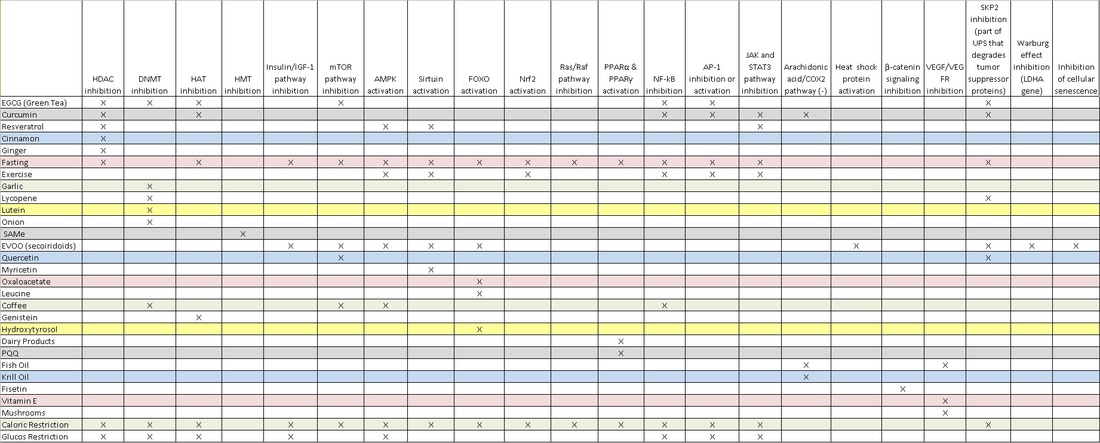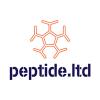I have created this matrix based on the SENS Organization's "A Reimagined Research Strategy for Aging." The idea is to identify supplements that will act as prevention or reversal of the 7 areas as suggested by SENS to have the greatest impact on aging. I have chosen the following supplements based upon a cursory search on the internet. I am presenting it for discussion and refining. Please feel free to recommend supplements I have not included and provide any citations that you believe will support any claims. This is a working document and I expect that it will be changed and revised based upon community input.
Also note that the rating system needs to be more clarified. The ratings do not rate the supplements against each other. I would be willing to hear any suggestions as to how to rate them.
The ranking 1-3 rates the reliability of the information sources.
The ranking A-C rates the effectiveness in inhibition or prevention and reversal if possible.
These rankings were compiled pretty much on the fly as I examined these supplements and need finer revision and clarification. I'm working on it.
Edited July 6, 2013
|
Supplement
|
Repleni SENS
|
Onco SENS
|
Mito SENS
|
Apopto SENS
|
Glyco SENS
|
Amylo SENS
|
Lyso SENS
|
Noot
|
Telomere Inhibitor
|
Telomere Protector
|
Telomere Activator |
|||||||
|
0
|
2
|
3B
|
0
|
3A
|
3A
|
3B
|
3C
|
0
|
0
|
0
|
||||||||
|
TA-711
^
|
0
|
0
|
0
|
0
|
3A
|
0
|
0
|
0
|
0
|
0
|
0
|
|||||||
|
0
|
1
|
0
|
2
|
3A
|
3B
|
3C
|
0
|
0
|
0
|
3A
|
||||||||
|
3B
|
3B
|
3
|
3
|
0
|
0
|
0
|
0
|
0
|
0
|
3A
|
||||||||
|
1
|
3A
|
3A
|
1
|
0
|
0
|
1
|
0
|
0
|
3A
|
0
|
||||||||
|
L-Carnosine
(2) ! #
|
3A
|
2
|
3
|
3
|
3A
|
0
|
0
|
0
|
0
|
3B
|
0
|
|||||||
|
Blueberry Extract (2)
|
3A
|
2
|
2
|
2
|
2
|
2
|
0
|
2
|
0
|
2
|
0
|
|||||||
|
Resveratrol (5)(6)
#
|
3B
|
3A
|
3A
|
3
|
0
|
0
|
0
|
1
|
3A
|
2
|
||||||||
|
Ginseng Extract
|
3C
|
3B
|
3
|
3
|
2
|
3B
|
0
|
2
|
0
|
3
|
0
|
|||||||
|
Curcumin (6) #
|
2
|
3A
|
0
|
0
|
0
|
3B
|
0
|
1
|
3
|
0
|
0
|
|||||||
|
Milk Thistle
|
0
|
3B
|
0
|
3
|
0
|
3B
|
0
|
0
|
3A
|
0
|
0
|
|||||||
|
(EGCG) (5)(6) #
|
3B
|
3A
|
3
|
3
|
3B
|
3B
|
0
|
2
|
3B
|
0
|
0
|
|||||||
|
Quercetin #
|
0
|
3B
|
3A
|
3
|
0
|
3C
|
3
|
2
|
3B
|
0
|
0
|
|||||||
|
Alpha Lipoic Acid (1)
#
|
2
|
3B
|
3
|
3
|
3A
|
0
|
3
|
3
|
0
|
3
|
0
|
|||||||
|
ALCAR (1) # |
0
|
0
|
3
|
3
|
0
|
3B
|
0
|
3
|
0
|
3
|
0
|
|||||||
|
Coenzyme Q10 (1)
#
|
3C
|
3B
|
3
|
0
|
3C
|
2
|
3
|
0
|
0
|
3
|
0
|
|||||||
|
Vitamine C #
|
3B
|
3B
|
3
|
3
|
3C
|
2
|
3
|
0
|
0
|
3
|
0
|
|||||||
|
Vitamine E
|
2
|
3B
|
2
|
0
|
1
|
3C
|
2
|
1
|
3C
|
2
|
0
|
|||||||
|
He Shou Wu
|
3C
|
3B
|
0
|
0
|
0
|
2
|
0
|
1
|
0
|
0
|
0
|
|||||||
|
Benfotiamine #
|
2
|
0
|
3
|
0
|
3B
|
3B
|
3
|
1
|
0
|
0
|
0
|
|||||||
|
Vitamin D/D3 (5)
#
|
2
|
3A
|
2
|
3B
|
0
|
3B
|
0
|
1
|
3C
|
0
|
0
|
|||||||
|
Caffeine (5)
|
0
|
2
|
3
|
0
|
0
|
3C
|
0
|
3
|
0
|
0
|
0
|
|||||||
|
Cinnamon
|
0
|
3B
|
0
|
0
|
2
|
3B
|
0
|
3
|
0
|
2
|
0
|
|||||||
|
Grape Seed Extract #
|
0
|
3B
|
0
|
0
|
3B
|
3B
|
3B
|
2
|
0
|
0
|
3B
|
|||||||
|
Creatine
|
3C
|
0
|
3A
|
0
|
0
|
0
|
0
|
2
|
0
|
0
|
0
|
|||||||
|
B-complex B6/B9/B12
|
2
|
1
|
3A
|
3B
|
2
|
0
|
2
|
2
|
0
|
0
|
2
|
|||||||
|
IP6
|
0
|
3A
|
3A
|
0
|
0
|
3B
|
3B
|
0
|
3A
|
0
|
0
|
|||||||
|
Centrophenoxine #
|
0
|
0
|
0
|
3B
|
0
|
3B
|
3B
|
3A
|
0
|
0
|
0
|
|||||||
|
Melatonin
|
3A
|
3A
|
3B
|
3A
|
0
|
3C
|
0
|
2
|
3
|
0
|
0
|
|||||||
|
NAC #
|
0
|
2
|
3C
|
2
|
3A
|
0
|
0
|
0
|
0
|
0
|
2
|
|||||||
|
L-Taurine !
|
3C
|
2
|
3A
|
0
|
3C
|
0
|
1
|
0
|
0
|
0
|
0
|
|||||||
|
L-Histidine !
|
0
|
0
|
3C
|
0
|
3C
|
0
|
0
|
2
|
0
|
0
|
0
|
|||||||
|
Fisetin (6)
|
0
|
3A
|
3
|
0
|
3
|
3A
|
0
|
3A
|
3A
|
0
|
0
|
|||||||
|
PQQ (6) #
|
0
|
3A
|
3A
|
0
|
0
|
3A
|
0
|
2A
|
0
|
0
|
0
|
|||||||
|
Fish Oil (6)
|
0
|
3A
|
3A
|
0
|
3B
|
0
|
3A
|
2B
|
3B
|
0
|
0
|
|||||||
|
SAMe (6)
|
2
|
3A
|
3B
|
0
|
0
|
3B
|
0
|
3B
|
0
|
0
|
0
|
|||||||
|
Olive Leaf Extract (6)
#
|
0
|
3A
|
0
|
0
|
3A
|
0
|
3A
|
2B
|
3A
|
0
|
0
|
|||||||
| Cats Claw |
0
|
3B
|
3A
|
0
|
0
|
0
|
0
|
0
|
0
|
0
|
0
|
|||||||
|
Pycnogenol
|
0
|
3B
|
0
|
3B
|
0
|
3A
|
0
|
2A
|
0
|
0
|
0
|
|||||||
|
Epitalon
|
0
|
3A
|
0
|
0
|
0
|
0
|
0
|
0
|
0
|
0
|
3A
|
|||||||
|
Lithium (5)
%
|
3A
|
3B
|
3A
|
0
|
0
|
3A
|
3A
|
3A
|
0
|
0
|
3A
|
|||||||
|
DHEA # +
|
||||||||||||||||||
|
Lion's Mane Mushroom +
|
3
|
|||||||||||||||||
|
Melatonin +
|
3
|
|||||||||||||||||
|
Choline Bitartrate +
|
3
|
|||||||||||||||||
|
Piracetam +
|
3
|
|||||||||||||||||
|
L-Tryptophan +
|
||||||||||||||||||
|
Zinc #
|
0
|
2
|
0
|
0
|
0
|
0
|
0
|
0
|
0
|
0
|
3
|
|||||||
|
Legend Powerfull Combinations: (1) ALCAR, Alpha Lipoic Acid, Coenzyme Q10 - Reduces Lipofucin, Maintains Mitochondria Function, Protects Telomeres (2) L-Carnosine, Blueberry Extract - Increase stem cell proliferation by 80% (3) L-Carnosine, Benfotiamine and ALCAR synergistically to inhibit AGEs. (4) Curcumin and Vitamin D3 remove beta-amyloids from the brain. (5) Increased Autophagy per GV's "Autophagy – the housekeeper in every cell that fights aging." (6) Reduced epigenetic signaling to cancel cancer as seen in GV's "Slaying Two Dragons with One Stone". Notes: + Needs source citations ! If taking high dosages of L-Carnosine (over 1500 mg) - Taurine supplementation is recommended to prevent depletion in the kidneys. Taurine is also necessary for healthy enzime interactions at the cellular level. Histidine supplementation is recommended to prevent histimine depletion which is important to a healthy immune system. Higher levels of Histidine in the system can reduce inflammation. In addition to their anti-AGE action, Carnosine and Histidine protect against alcohol-induced liver damage and depression. ^ Unfortunately, the specific types of AGEs affected by alagebrium, also known as ALT-711, are more important in rats than humans. The promising results in animals were never replicated in human studies. # Supplements on Vincent E. Giuliano's regimen list in the Anti-Aging Firewalls blog. % Prolonged high dosages may cause cancer, however prolonged low dosages have proven to extend human lifespans. |
||||||||||||||||||
|
|
||||||||||||||||||
Edited by solarfingers, 18 August 2013 - 01:18 AM.

























































